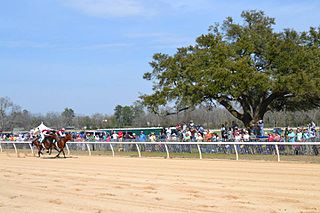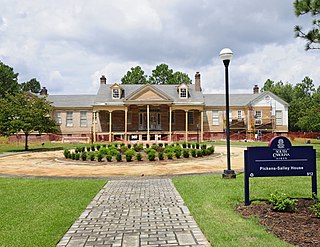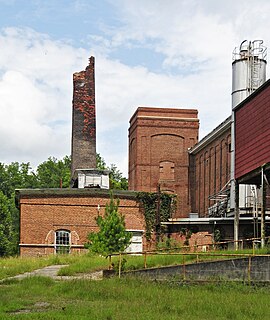
Aiken is the largest city in, and the county seat of, Aiken County, in western South Carolina, United States. With Augusta, Georgia, it is one of the two largest cities of the Central Savannah River Area. It is part of the Augusta-Richmond County Metropolitan Statistical Area.

Salley is a town in Aiken County, South Carolina, United States. The population was 398 at the 2010 census. It is part of the Augusta, Georgia metropolitan area. Salley is known for hosting the Chitlin Strut, a town-wide festival, every November.

The William Aiken House and Associated Railroad Structures make up a National Historic Landmark District in Charleston, South Carolina, that contains structures of South Carolina Canal and Railroad Company and the home of the company's founder, William Aiken. These structures make up one of the largest collection of surviving pre-Civil War railroad depot facilities in the United States. The district was declared a National Historic Landmark in 1963.

The Gov. William Aiken House was built in 1820 at 48 Elizabeth Street, in the Wraggborough neighborhood of Charleston, South Carolina. Despite being known for its association with Gov. William Aiken, the house was built by John Robinson after he bought several lots in Mazyck-Wraggborough in 1817. His house was originally configured as a Charleston single house with entrance to the house from the south side along Judith Street. The house is considered to be the best preserved complex of antebellum domestic structures in Charleston, South Carolina. It was the home of William Aiken, Jr., a governor of South Carolina, and before that the home of his father, the owner of South Carolina Canal and Railroad Company, William Aiken.

This is a list of the National Register of Historic Places listings in Aiken County, South Carolina.

Aiken Mile Track, located in Aiken, South Carolina, was built around 1936 during the heart of the Great Depression. Horses and horse racing is known as the “sport of kings.” Within that context it is significant that such a track should be built during a time of nationwide double-digit unemployment, and noteworthy in the sense that it contributed to Aiken's success as an equestrian center and “Winter Colony” during those difficult days. The landmark consists of outbuildings as well, including numerous barns. It is an accessible landmark, no more than a few miles from downtown Aiken. Aiken Mile Track was listed in the National Register of Historic Places on May 9, 1985.

Aiken Winter Colony Historic District I, is located in Aiken, South Carolina, It is noteworthy in that it is viewed as the district most closely identified with the history of the Aiken Winter Colony. The area features over 30 properties, many of which are large impressive mansions with stables. Most of the properties were constructed between 1882 and 1948. It is possible to enjoy the district via “from the street,” but note that many of the properties and mansions are either fenced, or otherwise protected by shrubs and stately trees. Aiken Winter Colony Historic District I was listed in the National Register of Historic Places on November 27, 1984.

Aiken Winter Colony Historic District II, located in Aiken, South Carolina. It is one of the three districts associated with the Aiken Winter Colony. This district, with over 100 properties, has approximately three times as many structures as Historic District I. District II also offers a number of impressive residences and outbuildings, as well the famous inn, Wilcox's.” The properties were constructed between 1880 and 1930. This visually appealing district was placed in the National Register of Historic Places on November 27, 1984.

Aiken Winter Colony Historic District III, located in Aiken, South Carolina. It has 42 properties, most of which were seasonal residences. The pleasing district varies from small cottages to large estates. Architectural styles include Queen Anne, Victorian, Colonial Revival, and Classical Revival, among others. The district also includes the Aiken Preparatory School. Aiken Winter Colony Historic District III was listed in the National Register of Historic Places on November 27, 1984.

The Aiken Training Track, with its banked turns and soft straightaways, was considered one of the best tracks in the country upon its completion in 1941. Notable surrounding buildings include a stable, shed and grandstand. The track and supporting structures, as well as other structures may be enjoyed and viewed from the quiet roads that border the large district. The Aiken County Training Track, located in Aiken, South Carolina, was listed in the National Register of Historic Places on May 9, 1985.

The Dawson-Vanderhorst House, located in Aiken, South Carolina. The house is one of the oldest remaining homes in Aiken County. In 1785, Charles Richmond acquired the property by grant. Shortly thereafter it appears that the home was built. There are a number of architectural features to the home that are representative of the time period in which it was built. The rear extensions to the home are not thought to be part of the original construction. The home is on private property surrounded by tall trees and brush. The Dawson-Vanderhorst House was listed on the National Register of Historic Places on June 29, 1976.

The Georgia Avenue-Butler Avenue Historic District is located in North Augusta, South Carolina. The district overlooks the city of Augusta, Georgia. The district was named to the National Register of Historic Places in 1984.

The Legare-Morgan House is a one-story clapboard structure built in Aiken, South Carolina around 1835. From 1850-1859 it was the home of the artist, poet and inventor, James Mathews Legare. In 1870 the property was sold to Thomas C. Morgan. The home, located in proximity to Aiken's downtown area, was listed on the National Register of Historic Places September 22, 1977.

The Pickens House, located in Aiken, South Carolina. It is reputed to have been built around 1829 by Governor Andrew Pickens for his son. In addition, the home is also noted for its early 19th century backcountry plantation architecture. Eventually the house was abandoned, and in 1929 it was moved from its original address near Edgefield to Aiken by a leading Aiken businesswoman and strong proponent of women's rights, Eulalie Chafee Salley. Around 1990 the home was again moved, this time to the campus of the University of South Carolina at Aiken. Much renovation work was taking place in the summer of 2012. The Pickens House was listed on the National Register of Historic Places on May 19, 1983.

The Vaucluse Historic District, located in Vaucluse, South Carolina in Aiken County. The district includes the mill, number of accompanying buildings, and over eighty mill village homes. The district is noteworthy in that it is considered to be oldest mill village in the state. No less significant, the mill building, completed in 1877, was based on the plans of architect Amos D. Lockwood. Lockwood's successor firm, Lockwood, Greene & Company, would later design around fifty of South Carolina's textile manufacturing facilities. The Vancluse Historic District was listed in the National Register of Historic Places on May 7, 1996.

Warrenville Elementary School, originally known as Warrenville Graded School, was constructed in 1925 and used to educate mill village children located in and around the Warrenville, South Carolina area. In 1954, two wings were added to the building. This Aiken County, South Carolina school was listed on the National Register of Historic Places on May 22, 2002.

The Chancellor James P. Carroll House, located in Aiken, South Carolina, was built in 1855 by James Parsons Carroll, Chancellor of South Carolina. Mr. Carroll was elected to the South Carolina House of Representatives in 1838, later served in the South Carolina Senate, and in 1859, was elected Chancellor of the Court of Equity. Carroll also served as a delegate to the Secession Convention and signed the Ordinance of Secession. The landmark was listed in the National Register of Historic Places November 23, 1977.

The Charles E. Simons Jr. Federal Court House is located in Aiken, South Carolina. It is significant for its association with the many federal construction programs of the Great Depression era. The building, designed by Columbia, South Carolina architects Lafaye and Lafaye, is an excellent example of a Georgian Revival building, a style often used during the 1920s and 1930s for government buildings in smaller towns. The Court House was listed in the National Register of Historic Places on December 10, 2003.

The B.C. Wall House, also known as the “Sesame Lodge,” is located at North Augusta, Aiken County, South Carolina. It was constructed in 1902 by Budd Clay Wall to serve as an overflow guest home from the Hampton Terrace Hotel. The home holds additional significance in that it was designed by a female architect, Wall's daughter, Martha Louise Wall Andrews. The house, which is very visible from the public street, contains elements of the Queen Anne, Classical Revival, and Bungalow Styles. It was listed on the National Register of Historic Places on November 27, 1992.

Charlotte Avenue–Aiken Avenue Historic District is a national historic district located at Rock Hill, South Carolina. It encompasses seven contributing dwellings in the Oakland section of Rock Hill. The district developed between about 1891 and 1935. Architectural styles represented include Classical Revival, Queen Anne, and Bungalow. Contributing buildings are the Hughes Walker House, Paul D. Farris House, Roy Z. Thomas House, Wilson House, Armstrong-Mauldin House, and Bays-Blackman House.























